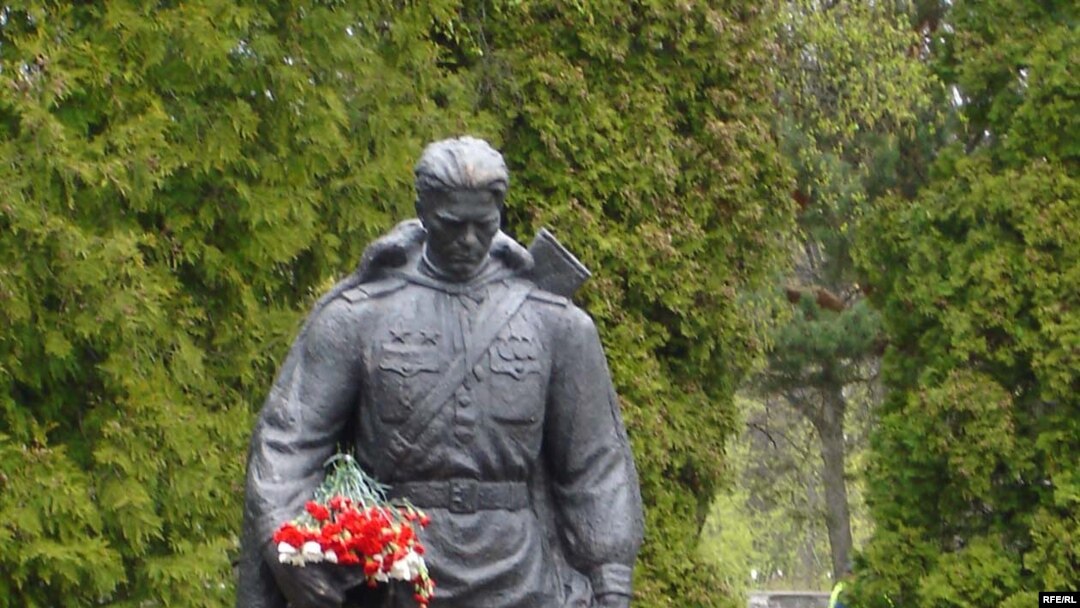But with the tensions still high following the recent removal of a Soviet war memorial from central Tallinn and subsequent rioting, the authorities are bracing themselves for May 9, the day when Russia traditionally honors its war dead.
Two weeks after riots in Tallinn, the damage is still visible.
Many shop fronts are still boarded over -- although some of them have makeshift "Open" signs.
Over two nights, disaffected and inebriated young people rioted and looted shops, leading police to arrest 1,200 people.
The authorities and the police are bracing themselves for more trouble. Grassroots ethnic-Russian militant groups have circulated calls for violent protests.
May 8 Or May 9?
At various locations around Tallinn today, government representatives and foreign diplomats are laying flowers at memorials and graves for the people -- soldiers, citizens, victims of the Holocaust -- who died during the war.
It will be the second time Estonia marks Memorial Day on May 8, the date marked in Western Europe and one day before Russia's traditional Victory Day holiday.
The Bronze Soldier, the Soviet-era memorial to the "liberators of Tallinn," the removal of which sparked all the protests, now sits at an out-of-the-way military cemetery.
Estonian Defense Ministry spokesman Madis Mikko says that wreaths will also be laid at the Bronze Soldier, however he noted that an official rededication of the monument will come later.
"[May 8] is a memorial day for the victims and the fallen of World War II," Mikko said. "We will not be opening -- we will not be opening the statue of the Bronze Soldier [on May 8]."
The statue has been accessible to visitors in its new location since early last week without restrictions.
Mikko said the official reopening will be delayed until the remains of the Soviet troops buried near the statue's original location can be reburied.
Mikko said 27 foreign embassies have accepted the invitation to participate in the wreath-laying ceremonies. There will, however, be one significant absentee. The Russian ambassador has announced he will be commemorating on May 9 instead.
Two Views Of History
The tug of war over dates reveals deeper divisions between Estonia and Russia.
Andres Kasekamp, a history professor at Estonia's Tartu University, explains that Estonia and the other Baltic states feel a natural affinity to the rest of Europe, as they were annexed by the Soviet Union in the early days of World War II.
"For us, World War II [took place between] 1939-45," Kasekamp says. "I think that's the European or Western understanding -- which Estonians and Europeans share. But for Russians, the conflict was the Great Patriotic War, which started only in 1941 with Hitler's attack on Soviet Russia. Soviet Russia, of course, had been an ally of Nazi Germany before that. But for us, the tragic events of World War II had already begun in 1939 with Soviet Army bases being brought into the country, and [in] 1940 with the full occupation of the three Baltic states by the Soviets."
The Soviet Union said that the three Baltic countries joined it voluntarily. Russia today maintains a similar view.
The differences over history aren't just academic, but can be felt on the streets of Tallinn -- as evidenced by the rioting two weeks ago.
Strangers In The Country Of Their Birth
Dmitry Klensky is one of the leaders of the Night Guard movement, which protected the Bronze Soldier memorial.
He says that Russians in Estonia feel that they are being discriminated against through no fault of their own.
"What is wrong for me here, psychologically, is that these people, a great majority of them, are not immigrants, in their minds at least, psychologically," Klensky says. "Because we are now regarded as immigrants [from Russia]. But forgive me -- a person went to sleep one night in one country and woke up in the morning in another. In this sense that person has not really 'moved here.'"
An Estonian citizen by birth, Klensky speaks impeccable Estonian.
He is frustrated with the government and says the Bronze Soldier was a focal point for the local Russian-speaking minority's identity and self-esteem. Its removal, he says, was a blow to their already low regard for the Estonian authorities.
In the Soviet period, Estonia's Russian population grew from around 10 percent in 1939 to 35 percent in 1989. It is now around 30 percent.
Klenski says Estonia's Russians suffer from greater unemployment than Estonians and have less access to education and political representation.
All these claims are routinely contested by the Estonian authorities. All ethnic Russians or Russian speakers are entitled to apply for citizenship once they pass an Estonian-language test.
But, for now, the boarded-up shops and celebrations on different days underscore Estonia's divisions.
Writing in the Estonian daily "Eesti Paevaleht" on May 7, Aleksandr Astrov, an academic at Tartu University, said the former site in central Tallinn of the Bronze Soldier memorial was Estonia's "ground zero" -- a place, he wrote, where both communities must start rebuilding mutual trust.
World War II: 60 Years On
A microsite devoted to RFE/RL's coverage of the 60th anniversary of the end of World War II in May 2005.
See also:
60 Years Later, Nagasaki Bomb Witness Is Finally Heard
For One Hiroshima Survivor, A Journey From Hate To Reconciliation


